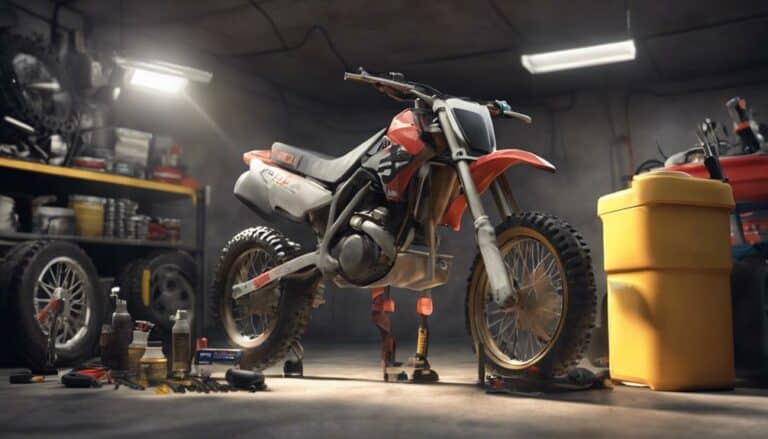When it comes to ensuring your dirt bike is in proper working condition before hitting the trails, think of it like checking the essential signs of a patient before surgery.
However, there's more to it than meets the eye. By meticulously inspecting key components like the engine, brakes, and suspension, you can prevent potential breakdowns and guarantee a safe and enjoyable ride.
But what about those critical yet often overlooked maintenance tasks that can make all the difference in your bike's performance? Let's explore some essential tips to keep your dirt bike running smoothly and efficiently.
Key Takeaways
- Check tire pressure, fluids, brakes, chain, and exhaust before every ride.
- Maintain proper levels and quality of fluids for engine health.
- Regularly inspect brake system components for safety.
- Monitor chain tension, sprocket wear, and air filter cleanliness for optimal performance.
Tire Pressure Check
Before starting on any ride, always consult your dirt bike's owner's manual to determine the recommended tire pressure for peak performance. Maintaining the correct tire pressure is vital for your safety and the longevity of your tires.
Use a tire pressure gauge to confirm that each tire is at the correct PSI level. Different terrains require different tire pressures, so adjust accordingly for best traction and control.
Proper tire pressure not only enhances your riding experience but also reduces the risk of accidents due to loss of control. Regularly monitor and maintain your tire pressure to prevent premature wear and potential accidents.
Fluid Levels Inspection
To guarantee your dirt bike operates smoothly and efficiently, it is essential to regularly inspect the fluid levels, including oil, coolant, and brake fluid, for leaks or burning to maintain proper lubrication and cooling. Monitoring these levels is important as dirty fluids or low levels can lead to engine damage and overheating. Below is a table outlining key points to contemplate during your fluid levels inspection:
| Fluid | What to Check | Why It's Important |
|---|---|---|
| Oil | Level and color | Proper lubrication for engine parts |
| Coolant | Level and quality | Prevent engine overheating |
| Brake Fluid | Level, color, signs of leaks or contamination | Ensure consistent braking performance |
Regularly checking these fluids and addressing any issues will help maintain your dirt bike's performance and extend its lifespan. Remember, replacing fluids near the service interval or if they appear dirty is essential for optimal functioning.
Brake System Examination
Regularly examining the brake system components, including pads, rotors, and calipers, is imperative for ensuring peak braking performance and rider safety. Before each ride, inspect the brake pads for wear. Replace them every 6,000-9,000 miles or when they reach 1 mm of material for best safety.
Check the rotors for any signs of warping, scoring, or thickness below the manufacturer's recommendations. Make sure the calipers are functioning correctly without any leaks or sticking issues.
Riding in challenging terrains like mud or sand may accelerate brake wear, necessitating more frequent brake system checks. Remember, a well-maintained brake system is essential for your safety and control in diverse riding conditions.
Chain and Sprocket Evaluation
When evaluating the chain and sprockets on your dirt bike, start by checking the chain tension as per the owner's manual specifications for proper adjustment. Proper chain tension is important for smooth operation and to prevent premature wear.
Inspect the sprockets for signs of wear and make sure they're aligned correctly. Misaligned sprockets can lead to uneven wear on the chain and affect performance.
Regularly lubricate the chain with a motorcycle-specific lubricant to prevent rust and maintain flexibility. Failure to lubricate the chain can result in increased friction and wear.
Clean the chain and sprockets regularly to remove dirt and debris that can cause premature wear.
If you notice significant wear or damage, it's essential to replace the chain and sprockets promptly to avoid safety hazards and maintain the best performance on your dirt bike.
Air Filter and Exhaust Assessment
Evaluating the air filter and exhaust system is essential for maintaining peak engine performance and efficiency on your dirt bike. When inspecting the air filter, check for debris buildup to guarantee clean airflow, important for peak engine performance. In dusty terrains, clean or replace the air filter after each ride to prevent engine damage. Turning to the exhaust system, look out for leaks, damage, or restrictions that could affect the air/fuel ratio. Upgrading the exhaust system can greatly enhance airflow, boosting overall bike performance. Proper installation and functioning of the exhaust system are crucial for improving engine efficiency and power output. To summarize:
| Point | Importance |
|---|---|
| Air Filter Check for Debris Buildup | Clean airflow for peak engine performance |
| Air Filter Replacement in Dusty Areas | Prevent engine damage |
| Exhaust System Inspection | Maintain air/fuel ratio |
| Upgrading Exhaust System | Enhance bike performance |
| Proper Exhaust Installation | Improve engine efficiency and power output |
Conclusion
To summarize, ensuring your dirt bike is in proper working condition before riding is essential for the best performance. Remember to regularly check tire pressure, inspect fluid levels, examine the brake system, evaluate the chain and sprockets, and assess the air filter and exhaust.
By maintaining these key components, you'll keep your bike running smoothly and safely. Just like a well-oiled machine, a properly maintained dirt bike will provide you with a thrilling riding experience every time.

